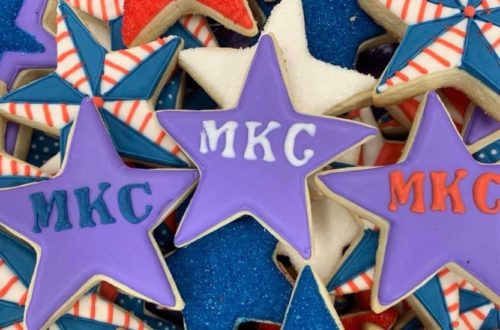
New School Welcoming: Student Sponsorship Programs
By Stacy Allsbrook-Huisman
Military-connected students adjusting to a new school commonly experience feelings of isolation, confusion, and searching for support. Students switching schools during the COVID-19 pandemic seemed to experience these feelings even more intensely.
In an online round table discussion, Secretary of Education Miguel Cardona hosted a Zoom call with a dozen military-connected students from across the globe to chat about how their lives have been impacted by the coronavirus pandemic. What was learned from students and their experiences can be applied not only to schools that are still in hybrid or virtual environments, but also as a basis for programming to help military-connected students feel more welcome when entering a new school anytime in the future.
During the round table discussion, which included students ranging from elementary school kids to seniors in high school, every child, without exception, talked about their struggle to finding their footing after a move and the need for a universal student sponsorship program.
Erik,* a high school freshman in Northern Virginia, moved during the summer of 2020 during the height of the pandemic. He describes his experience as confusing and isolating.
“Moving from a state that stayed in person for five days a week to a state that went 100 percent virtual for seven months—it was confusing. The entire community seemed locked down. I understood why, but it felt like no one could see me. For a new student, how are kids supposed to process and embrace a new school when they don’t even know I’m here?”
Other students echoed Erik’s experience and concerns. Students and parents attending the call said there was a need for connecting new students with their school, peers, and community—especially during school closures. PCSing during the pandemic exaggerated feelings of isolation for new students. There was a resounding consensus that a student sponsor program would help new students—military-connected or not—feel more supported in school.
Many schools already have a student sponsor or student ambassador programs in place. And military kids remembered fondly their past experiences with sponsor programs and how they connected them with peers when they most needed it.
“One way our school helps military students is by having a military student ambassador welcome the new student. This helps ease some of the socialization stress we face from going from one school to another in such a short period of time,” says Elizabeth, a twelfth-grade student at Knob Noster High School in Missouri.
Abby,* a seventh-grade student in Virginia, says her experience with student sponsor programs made her feel more accepted into the school community more quickly. Her last school in Florida had a family match program set up by the Parent-Teacher Association (PTA), which matched similar families—fourth grade with fourth grade, military families with military families, and so on. Existing families in the district “sponsored” new families.
“It was fun. We had ice cream socials with our new friends, and they were someone we could call if we had questions, too. It really made a difference how new kids felt about being new,” Abby says.
Ways to Create a Student Sponsor Program
A student sponsor program can work at any age and any grade and through a range of platforms and executions. While PTAs are great for organizing sponsor programs because they are often more flexible in planning events and providing funding, a school can easily adopt a sponsor program in the form of a student ambassador program through their Student Government Association (SGA) or through after-school clubs. As a tool for SGA or a club, a sponsorship program can offer leadership roles for middle and high school students and allow new students, once settled, to pay it forward to the next family.
However, the most overlooked place for a student sponsor program is likely in the classroom. Teachers have an opportunity to let students take the lead in helping a new classmate feel a little more settled. Small gestures like sitting together at lunch, showing new students around the school, and handing out a helpful guide of the area can bolster confidence in students that are new to the school. The class can develop a living document, like a community fact sheet, where students can jot helpful tips and tricks, favorite places to eat, or best places to have a birthday party. That information can be given to new students upon arrival as a welcome packet.
Support Students Upon Arrival, During the Year, and When They Leave
A good start to any student sponsor or ambassador program is to support the student as soon as they arrive at a new school. Then students need support throughout the school year too—and many military students leave before the end of the official school year. A student sponsor program should help those students when they exit a school as well. In the military, it’s called “Hails and Farewells.” And it’s an easy way to emotionally support students who live a highly mobile lifestyle like military kids.
Hails: A student sponsor program’s priority is to welcome all new students—military connected or civilian—to their school with a welcome. It could be as small as assigning one peer to help the new student find their way around the building or have a buddy to sit next to at lunch. Or it could be a larger, broader program that allows student sponsors to have socials, school spirit wear, and more. The goal is to make new students feel welcome, connected, and included on their first day so they can focus more on school and less on being new.
Farewells: It’s hard to leave a school mid-year or before school has officially ended. A student sponsor program focuses on ensuring all moving students feel like they were valued at the school and will not be forgotten by giving them a send-off gift from the school. From ensuring they get a yearbook at the end of year to coordinating letters of farewell from their teachers or gifting a simple school t-shirt, any supportive gesture will help a student who is feeling anxious or emotional about leaving their school.
Benefits for Students Who Stay in the School
A school student sponsor or ambassador program is an essential program for supporting highly mobile students like military kids. But it’s also a great way to teach empathy and build leadership for students who will stay in the district for a long time—perhaps the entirety of their school career. Students who volunteer as sponsors will better understand the challenges of their military-connected friends, which will broaden their perspectives in their own lives while also helping them welcome the next new student even better.
Benefits for Military-Connected Students (and Other Mobile Students!)
It’s vital for the emotional well-being of tweens and teens changing schools to land at a school that understands the challenges of being in a military-connected family. Sponsor programs need to be more than a plan on paper. Programs need resources and commitment from school organizations like the PTA or from the school and parents themselves. Student sponsor programs help all new students thrive in school faster so students can focus on academics rather than the social and emotional part of settling into a new community. For military families that’s important, because orders to move often come when they least expect it.
In whatever way a school plans and executes its student sponsorship program, the most important aspect is to truly commit to helping new students and providing resources they need at the time they really need them. When the Secretary of Education asked for final comments, Abby said it best: “My school said they wanted to start a school wide student sponsor program, but they didn’t do anything that related to helping new kids settle. My mom did all the work for them, and they didn’t really try. Nice teachers, but they didn’t get us military kids.”
*Erik and Abby are the children of the author.
Stacy Huisman is a mother of two, Air Force spouse, and freelance writer. An advocate with a passion for military-connected children and their families, Stacy is coauthor of Seasons of My Military Student: Practical Ideas for Parents and Teachers. She’s dedicated the last decade to understanding the challenges military kids face when changing schools.
More about supporting students during transitions:



